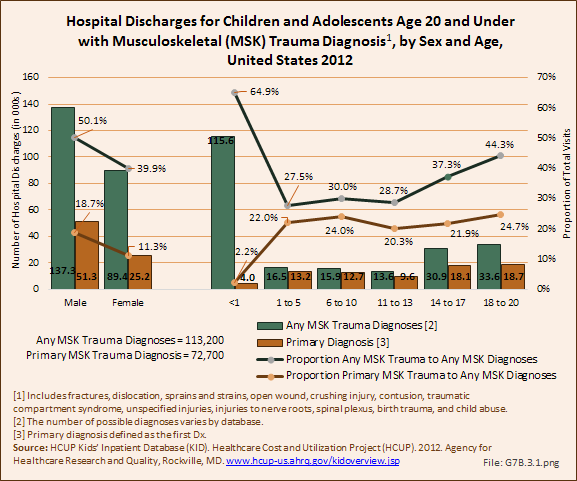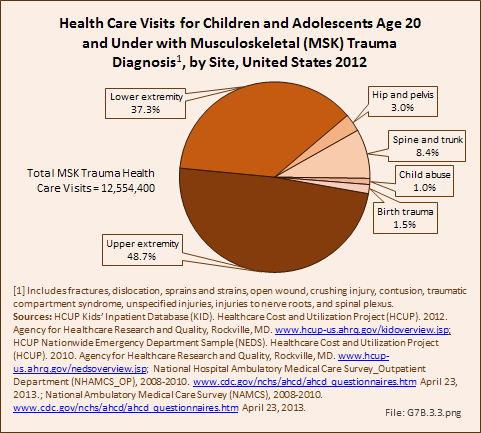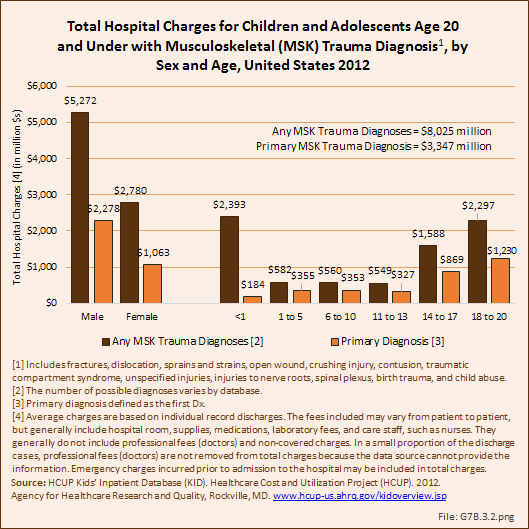

Trauma resulting in musculoskeletal injury was diagnosed in 12.9 million children and adolescent health care visits in 2012, of which 90% (11.6 million) had a primary diagnosis of musculoskeletal injury. Only a small number were serious enough to require hospitalization. Among any trauma musculoskeletal injury diagnoses, 226,700 children and adolescents were hospitalized, with 76,600 hospitalized with a primary diagnosis of a musculoskeletal injury. (Reference Table 7.1.1 PDF [1] CSV [2] and Table 7.1.2 PDF [3] CSV [4])
Males had nearly double the injury rates with hospitalization of females for both any diagnoses or as a primary diagnosis. Hospitalization for musculoskeletal injuries were greater between the ages of 1 and 10 years than for the middle ages of 11 to 13 years. However, they were highest for the oldest adolescents, age 14 years and older. Children under the age of one year had a high rate of musculoskeletal injury for any diagnosis with hospitalization, primarily due to a diagnosis of birth trauma, and reflected in the much lower rate of hospitalization with a primary trauma diagnosis.
Musculoskeletal injury as a primary diagnosis accounted for 15% of hospitalizations for any musculoskeletal condition diagnosis, and 1.1% of hospitalizations for any health care reasons for children and adolescents age 20 years and younger. For all but the youngest age (under 1 year), which is skewed by birth trauma, trauma accounted for 20% to 25% of all hospitalization for any musculoskeletal diagnoses. (Reference Table 7.4 PDF [5] CSV [6])

Trauma to the upper extremity account for nearly half (49%) of all trauma health care visits by children and adolescents. This was followed closely by lower extremity trauma (37%). Spine and trunk injuries were 8%, with hip and pelvis at 3%. Birth trauma was 1.5% of all health care visits, but accounted for nearly half (48%) of hospital discharges for musculoskeletal trauma diagnoses. Child abuse was reported in 1% of all health care visits for trauma. Trauma to multiple sites was cited in about 2% of cases. (Reference Table 7.1.1 PDF [1] CSV [2])

Total charges averaged $35,400 for a mean 4.2-day stay when children and adolescents were hospitalized with a diagnosis of musculoskeletal injury along with other medical conditions. With a primary diagnosis of injury, the stay was shorter (3.2 days), but mean charges were higher at $43,700, likely due to the high number of birth trauma cases. Mean charges were highest for adolescents of high school age or older (14 to 20 years). Total hospital charges for all primary musculoskeletal injury discharges in 2012 were $3.35 billion. (Reference Table 7.4 PDF [5] CSV [6])

Links:
[1] https://bmus.latticegroup.com/docs/T7.1.1.pdf
[2] https://bmus.latticegroup.com/docs/T7.1.1.csv
[3] https://bmus.latticegroup.com/docs/T7.1.2.pdf
[4] https://bmus.latticegroup.com/docs/T7.1.2.csv
[5] https://bmus.latticegroup.com/docs/T7.4.pdf
[6] https://bmus.latticegroup.com/docs/T7.4.csv